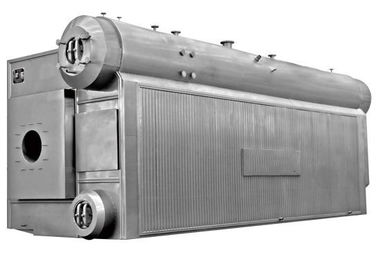Product Discription
Series Double Drum Chain Grate Biomass Water Boiler
The boiler main body is discharged from the double pan tube chain furnace of the SZL series, the boiler main body is arranged in the vertical direction of the double pan tube, and the boiler tube is equipped with the sider separator, the bottom pot sets the pollution prevention device, and the water cooling wall tube of the stove on the left and right sides . It adopts a light chain furnace and automatically puts the fuel in the recombustion chamber, convection tube after the furnace, the furnace tail is a coal stove or air preheater, and sends a blower, ventilator, and mix automatic dewatering machine. Fuel enters the chain of chains and burns in the furnace, and smoke passes through the furnace cylinder, the recombustion chamber, the convection tube, the coal stove or the air preheater to the tail flue and is finally discharged into the air through the dust collector, blower, and chimney.
Product Features
1. Blast Furnace Sector:
Boiler ventilation is dual. Dust treatment technology can make natural ventilation in front of the boiler, avoid air leakage, oil spillover and uneven ventilation, easy to operate, and has obvious advantages. More.
2. The highest security level:
Water is controlled by a micro-enterprise and provided automatically. With a system to prevent pressure and water shortage, safety is guaranteed.
3. Life and durability:
The special design, advanced production equipment and strict quality testing of boilers ensure the quality and normal service life of each new boiler for more than 20 years.
4. Under the ecological noise:
The initial emission level of the boiler is low, and the tail has efficient scrubbers and low noise fans, so its emission meets the national environmental requirements.
5. Manufacturing standards:
Boiler components are manufactured in accordance with national and international standards (ISO). Each stage of production is strictly in accordance with the advanced production technology, and ensure the reliability of product quality.
Technical Parameters
| Thermal Power |
MW |
1.4 |
2.8 |
4.2 |
5.6 |
7 |
10.5 |
14 |
17.5 |
| Outlet Pressure |
MPa |
1.0 |
1.0 |
1.0 |
1.0 |
1.0 |
1.0/1.25/1.6 |
1.0/1.25/1.6 |
1.0/1.25/1.6 |
| Outlet Temperature |
℃ |
95 |
95 |
95/115 |
95/115 |
95/115 |
95/115 |
95/115 |
95/130 |
| Feed Water Temperature |
℃ |
70 |
70 |
70 |
70 |
70 |
70 |
70 |
70 |
| Thermal Efficiency |
/ |
≥83% |
|
| Fuel |
/ |
Biomass particles |
|
| Fuel Consumption |
Kg/h |
348.6 |
685 |
938.8 |
1366.2 |
1694.6 |
2583 |
3410 |
4272 |
| Heating area |
m2 |
81.26 |
165.26 |
233 |
351.2 |
391 |
547.6 |
826 |
1110 |
| Grate area |
m2 |
2.8 |
6.04 |
8.64 |
11.71 |
13.64 |
15.33 |
19.16 |
26.3 |
| Power consumption |
Kw |
25.3 |
34 |
62.4 |
76.2 |
87.2 |
138 |
206.5 |
218 |
| water volume |
m3 |
3.59 |
6.67 |
8.33 |
8.42 |
12.7 |
13.9 |
15.6 |
18 |
Note: the fuel consumption in the table is calculated on the basis of the low calorific value of biomass particles 17084KJ/Kg (4085Kcal/Kg). If the low calorific value of biomass fuel is larger than this value, the corresponding fuel consumption will be more economical than the value in the table.
External and Interface Dimension of SZL Biomass Hot water boiler
| Steam Capacity |
t/h |
1.4 |
2.8 |
4.2 |
5.6 |
7 |
10.5 |
14 |
17.5 |
|
Transport Dimension
|
L |
mm |
5600 |
7380 |
6900 |
7000 |
2800 |
8700 |
11900 |
10700 |
| W |
mm |
2500 |
2700 |
2660 |
3400 |
3020 |
3340 |
3200 |
3000 |
| H |
mm |
3500 |
3740 |
3500 |
3700 |
3500 |
3570 |
2360 |
4000 |
| Maximum Transport Weight |
/ |
t |
24.5 |
31 |
30 |
32.5 |
34 |
35 |
35 |
36 |
| Outlet Water Valve |
DN |
mm |
100 |
125 |
150 |
200 |
200 |
250 |
2*200 |
2*200 |
| Feed Water Valve |
DN |
mm |
100 |
125 |
150 |
200 |
200 |
250 |
2*200 |
2*200 |
| Safety Valve Diameter |
DN |
mm |
1*50 |
2*40 |
2*50 |
2*50 |
2*50/80 |
100*80 |
2*100 |
2*100 |
| Drain Valve Pipe Diameter |
DN |
mm |
2*40/50 |
3*40 |
40/3*50 |
4*40 |
6*40 |
6*40 |
8*40 |
8*40 |
| Chimney Diameter |
φ |
mm |
350 |
410 |
530 |
720 |
750 |
950 |
1000 |
1200 |
Remarks: We will reserve rights to change the above mentioned data due to continuous policy transformation and product improvement.

 Your message must be between 20-3,000 characters!
Your message must be between 20-3,000 characters! Please check your E-mail!
Please check your E-mail!  Your message must be between 20-3,000 characters!
Your message must be between 20-3,000 characters! Please check your E-mail!
Please check your E-mail! 












